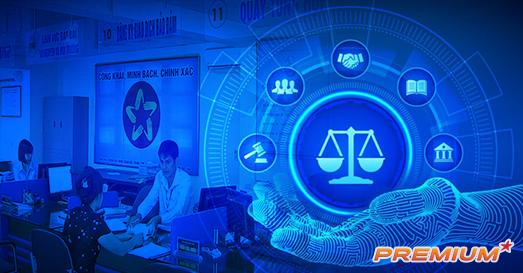It is common in Vietnam that one product, one matter is managed by several ministries and government agencies.
The manager of a food processing business has said: “One of our sausages is managed by seven ministries and agencies. They are the Ministry of Health, the Ministry of Agriculture and Rural Development, the Ministry of Industry and Trade, the Ministry of Natural Resources and Environment, the Ministry of Finance (together with the General Department of Taxation and the General Department of Customs), the Ministry of Science and Technology and the Ministry of Public Security”.
Problems in state management were exposed clearly after the incident last July in which dozens of people were poisoned after eating vegetarian pate products labelled Minh Chay, produced by Hanoi-based Loi Song Moi (New Lifestyle) Two-Member Co., Ltd.
This vegetarian pate product was certified by the Sub-department of Quality Management of Agro-Forestry-Fisheries under the Hanoi Department of Agriculture and Rural Development and inspected by the Market Management Administration under the Ministry of Industry and Trade. The Department of Food Safety of the Ministry of Health is in charge of food safety management.
Thus, at least three ministries and agencies were involved in the management of the product. Many inspection teams were established to inspect the operation of the producer, and the company was suspended.
In a petition sent to the Government at a session of the XIV National Assembly in 2019, voters representing the Association of Small and Medium Enterprises reported that the petroleum sector is under the management of the Ministry of Industry and Trade, but in fact, many ministries and agencies are involved in the management such as the Ministry of Public Security, the Ministry of Science and Technology, the Ministry of Natural Resources and Environment, the Ministry of Finance...

On April 15, Prime Minister Pham Minh Chinh chaired the first meeting of the new cabinet. Photo: Nhat Bac
The fact that one liter of petrol is managed by more than five ministries and agencies with different regulations has caused many difficulties for businesses.
During the National Assembly’s discussion on the amended Law on Public Investment in late 2018, deputy Tran Quang Chieu mentioned that the two ministries jointly manage the state budget.
Specifically, the Ministry of Planning and Investment manages the allocation and expenditure of investment while the Ministry of Finance manages the allocation of recurrent expenditures.
This leads to a situation where resources are scattered, overlapping, and inconsistent in management, thereby reducing the efficiency of budget expenditures, and creating lack of cohesion between recurring expenditure and investment expenditure.
“Of 170 countries and territories, only Vietnam has two ministries that manage state budget capital, while the scale of our economy as well as the size of our budget is not large. So, there's no reason to give this task to only one agency," said National Assembly deputy Tran Quang Chieu.
Just cutting the top

Hệ thống Thông tin báo cáo quốc gia, Trung tâm Thông tin, chỉ đạo, điều hành của Chính phủ, Thủ tướng Chính phủ khai trương ngày 19/8/20200
At the beginning of the 14th Government term, the Prime Minister established a working group to help the cabinet head to review the overlaps and contradictions in the management and administration of ministries and government agencies.
In 2017, the head of the Prime Minister's working group led by the Chairman of the Government Office at that time - Mr. Mai Tien Dung – released a shocking number: on average, enterprises spent nearly 30 million working days and nearly VND15 trillion a year inspecting import and export goods.
There were nearly 100,000 items that had to be inspected at customs clearance, but the rate of violations detected through inspections was only about 0.06%.
“A car manufacturing line was checked when it was imported, but when it was assembled at the factory, inspectors from another ministry came to check it again,” said Mr. Mai Tien Dung.
The Prime Minister at that time ordered that only one product should be managed by one management agency.
The efforts of the Prime Minister, the Government and the Working Group during the past term helped to cut and simplify 63% of required business conditions and 68% of the list of specialized goods.
However, businesses still complained that they had to "go through many doors" to perform administrative procedures and had to "receive" many inspection teams.
No matter how much effort is made in the reform of administrative procedures, it still exists. If one procedure is cut, another procedure appears. The root of the problem lies in overlapping management, and duplication of functions and tasks between ministries and agencies.
The root in the apparatus

Minister of Home Affairs Pham Thi Thanh Tra.
The Communist Party of Vietnam has clearly realized the root of this matter and has issued many important decisions in Resolution 18 from the 6th session of the 12th Central Party Committee, as follows:
Urgently reviewing, resolutely amending, supplementing and perfecting functions, tasks, powers, responsibilities, and working relationships among ministries, sectors and organizations under ministries; thoroughly overcoming the duplication and overlapping of functions and tasks so that an organization can undertake many tasks; one organization to assume and take responsibility of one task.
The Party also requested to review and reduce the number of inter-sectoral coordination organizations, especially those with full-time assisting departments.
The resolution also noted to continue studying and clarifying the theoretical and practical basis of the multi-sectoral and multi-field management scope of a number of ministries and agencies, especially those with similar functions and tasks in order to have appropriate solutions. The aim is to implement consolidation, organizational arrangement, and reduction of these agencies in the next term, such as those in the field of transport - construction; finance - investment plan; ethnicity - religion.
One of the key tasks stated in the Resolution of the 13th Party Congress is "Building a clean, strong, streamlined political system with effective and efficient operation".
Implementing the Party's guidelines, the Ministry of Home Affairs is developing a project on the government structure for the 2021-2026 term.
Home Affairs Minister Pham Thi Thanh Tra said that one of the solutions proposed by the ministry to streamline the government apparatus is "Promoting the renewal of the government apparatus to be lean, effective and efficient on the basis of reasonable structure of multi-sectoral ministries”.
This is to thoroughly overcome the overlaps and interferences in functions and tasks between ministries and ministerial-level agencies; and ensure the principle of one task assigned to only one agency.
The draft Resolution on the master program of state administrative reform for the period of 2021 - 2030 mentions many notable points about how to organize the state administrative apparatus in the coming period. The Ministry of Home Affairs is collecting opinions from ministries and agencies for the last time to submit to the Prime Minister for promulgation of the resolution.
In particular, the Ministry of Home Affairs proposed strengthening innovation and improving working methods in order to improve the capacity of direction and administration, improve operational efficiency, and streamline the organizational system of administrative agencies at all levels as prescribed; and strive to reduce the number of ministries and ministerial-level agencies to 16-18 from the current number of 22, drastically reducing intermediary organization”.
To do this, the Ministry of Home Affairs has set out a number of tasks, including formulating and perfecting policies and laws on the organization of the state administrative apparatus.
At the same time, it proposed researching a model of government organization in the context of promoting the development of e-government and digital government and actively participating in and adapting to the fourth industrial revolution; and researching a pilot model of independent agencies with law enforcement functions in a number of fields, moving towards separating the law enforcement function from ministries and ministerial-level agencies to refine the state administrative apparatus.
The Ministry of Home Affairs also emphasized reviewing and clearly defining the tasks of administrative agencies, the tasks that need to be decentralized to local authorities and subordinates; and the tasks to be transferred to enterprises and social organizations. On that basis, design and arrange the appropriate administrative apparatus at the central and local levels.
The Ministry of Home Affairs also said that it is necessary to study and clarify the theoretical and practical basis of the multi-sectoral management scope of a number of ministries and agencies, especially those with similar and overlapping functions and tasks to have suitable solutions.
Redesigning the operation of the Government

Minister of Information and Communications Nguyen Manh Hung.
The promotion of information technology application in the process of administration and direction of the Government apparatus is an indispensable element in the context of the 4.0 Revolution to help the government apparatus not only become streamlined and operate more effectively, but also be more transparent.
Therefore, the Ministry of Home Affairs has set the target of promoting the application of information technology, digital transformation and scientific and technological advances to develop e-Government and digital government, in order to improve productivity and operational efficiency of state administrative agencies at all levels; and improve the quality of public services provided to people and organizations.
At the National Committee on E-government meeting on March 10, Minister of Information and Communications Nguyen Manh Hung said that in the second quarter of this year, the Government will approve the e-Government Strategy Towards Digital Government.
According to Minister Nguyen Manh Hung, the most important feature of the digital government is to provide digital services to the people, the entire government apparatus to operate in a digital environment, using data and digital technology to redesign government operations to help decision-making and social management become more effective, leading the country's digital transformation.
The basic view of the development of digital government is that government activities should be safe in the digital environment, provide quality services and faster and more timely decisions, issue better policies, and solve major problems in socio-economic development.
The Digital Government Strategy sets five goals: To provide high-quality public services to the people; mobilize the broad participation of people and businesses; provide optimal operation of state agencies based on digital technology; and solve major problems in socio-economic development such as health, education, transportation...
The transformation from e-government to digital government is a fundamental transformation, from online public services to digital services. The concept of information technology system is replaced by digital platform, from a service-oriented approach to a data-driven approach; from the participation of state agencies to the participation of the state and people and businesses; from reforming administrative procedures to changing governance models...
The e-Government Strategy towards Digital Government sets six key tasks: to perfect the legal environment, develop the national digital infrastructure, develop the national digital platform, develop national data, develop national applications, and ensure national network safety and security.
Targets to 2025:
- 100% of national databases creating the foundation for e-Government development will be completed and connected and shared across the country.
- 100% of the Public Service Portal, the ministerial and provincial electronic one-stop information systems will be connected and share data with the National Public Service Portal.
- 100% of the reporting regime, periodic reports and socio-economic statistics reports (excluding confidential content) serving the direction and administration of the Government and the Prime Minister will be connected and integrated, and digital data on the National Reporting Information System and the Information Center will be shared, serving the direction and administration of the Government and the Prime Minister.
- Vietnam is among 70 leading countries in e-Government.
Thu Hang

It is time to reform the state administrative apparatus
Reforming the state administrative apparatus is a national policy which has been noted in resolutions of all eight national congresses of the Communist Party of Vietnam during the 35 years of Doi Moi (reform).

Further administrative reform needed
Vietnamese people and businesses are still struggling with administrative procedures and are being held back by an unstable business environment.